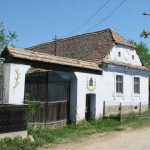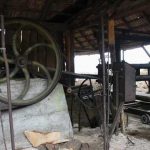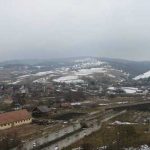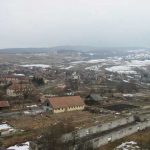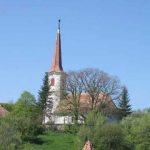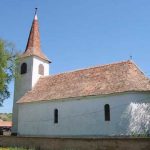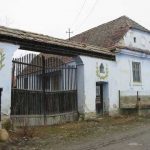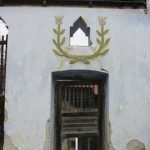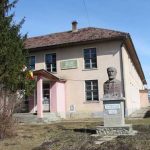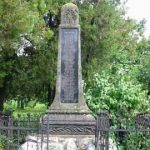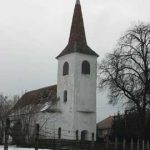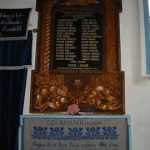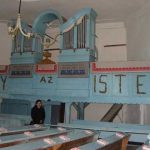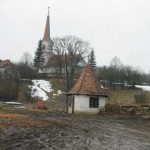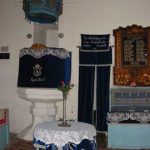- Introduction of the village
Simenfalva is the biggest settlement along the Also-Nyiko, it consists of 14 villages, it is an administrative centre. It lies where the Feher-Nyiko and the Alba stream flow into each other at a height 430-440 meters. It lies 5 kilometers from Rugonfalva, 7 kilometers from Szekelykeresztur and 21 kilometers from Szekelyudvarhely on the 135A county road. Its neighbors are ( from North to East) : Kiskadács, Nagykadács, Nagygalambfalva, Rugonfalva, Székelyszentmiklós and Nagymedesér. Its inner territory is 99 hectares. At its southern border on the Rez ( 932 meters high) there are beech forests. Nearby the Rez is the favorite picnic place of the villagers, Varhegy ( 880 meters high). Orban Balazs mentions it under the name of Kadicsa’s Castle.
- Demographical dates
The village has 1049 inhabitants, 1034 of them Hungarians and 15 Romanians. From the point of view of religion there are 894 Unitarians, 108 Reformed, 19 Roman-Catholics, 19 Orthodoxies, 6 Greek-Catholics, 1 Lutheran and 1 person has other religion.
- Touristic sights
The Reformed church was built in 1792 on the yard of the Szekely Mozes mansion. The church was bult by the Kiss family and the believers, they also used the building materials of the mansion mentioned earlier. Beginning with 1975 it belongs to the mother church from Rugonfalva.
The Szekely Mozes mansion was built before 1853 by Szekely Mozes the chamber man of the prince from Sofalva, later prince of Transylvania in the centre of the village, 200 kilometers north from the Nyiko. Prince Bathory Zsigmond gave Szekely Mozes and student Janos and his brothers as present 6 serf allotments from Simenfalva. After the death of the elder Szekely Mozes the son Szekely Mozes inherited the estate. The prince I. Rakoczi Gyorgy took it away from him accusing the former with unmorally and gave it to Glinkovszki Janos, chief captain of the German guard infantry in change for 4000 Hungarian forints. In 1636 the prince gave the estate as present to his counselor Szalanczy Istvan. According to Orban Balazs the building went to the Kiss family by the line of descent of the women. In 1960 the teacher Kiss Zsigmond built a new house on the bases of the old mansion.
- Culture in the village
The history of the schools: there are no documents left about the beginning of the teaching. According to the oral tradition in the time of prince Apafi Mihaly around the year 1670 there already existed teaching in the village. Secure dates we have from 1733 when the name of Pesti Samuel schoolmaster is mentioned. After this the names of most of the teachers are known. Up to the school year 1885-1886 it was a church school, but since then it is a state school. Since 1964 there is teaching up to the eighth grade. In 1974 there began to function a high school with an agricultural profile, it has been functioning with breaks for a while and it is not working since 1991. The building from 1970 is up to the actual demands, it has a laboratory and a gymnasium. In 1993 the school took up the name of Marosi gergely who was born at Simenfalva.
The cultural activity of the village was developed by the teacher Fazakas Denes, he organized an acting group and was the leader of the choir. This was continued by Nemes Ilona, Benke Andrásné, Szécsi Lenke, Nemes Lajos and Benke András. After 1985 cultural work was lead by Kovacs Irma, Kovacs Lajos and Szabo Arpad.
Nowadays cultural activity is more and more restrained to the school. There are events organized every year such as: carnival of the pupils, performances of the pupils from the school, “Perefernum” a contest in the knowledge of our native country, a contest in telling fairy-tales, contests with other schools, Santa Clause, Mothers’ Day and different memorial performances. The contest “Perefernum” has a long tradition, it was first organized in the 70’s by the teacher Szecsi Lenke. Its name comes from Latin and it means dowry, in this case the knowledge of the pupils about their native land accumulated during the years of study that they carry further when they leave the village.
In the village the youth organizes the ball of vintage, the people celebrate March 15 th and on May the 1 st everybody goes to the field on a picnic.
- Famous people born in the village
- Székely Mózes (155o-16o3) prince of Transylvania
- Dr. Elekes Dénes (188o-1937) lawyer, landowner, attending administrato
- Kozma Gyula (1853-191o) school principal
- Marosi Gergely (1832-1874) school principal
- Péter Sándor (1868-1938) Unitarian priest
- Elekes Ferenc (1935-) journalist, poet
- Farkas Árpád (1944-) poet, editor, organizer of cultural activities
- Fellowship connections
Since 1991 the village has fellowship connections with the village Kolesd from Zala county, Hungary .
- Photogallery

